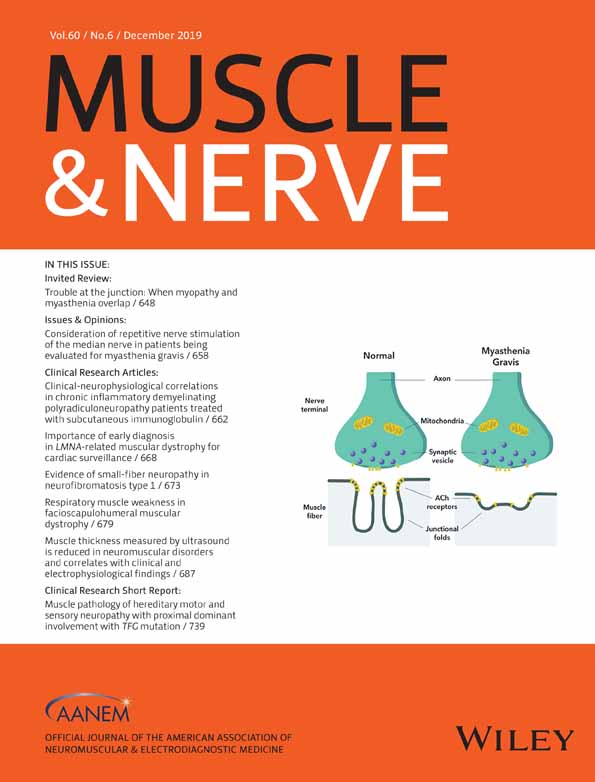X-linked myotubular myopathy and pulmonary blebs: Not just a muscle disorder
Corresponding Author
Robert J. Graham MD
Department of Anesthesiology, Critical Care and Pain Medicine, Division of Critical Care, Boston Children's Hospital, Boston, Massachusetts
Harvard Medical School, Boston, Massachusetts
Correspondence
Robert J. Graham, Boston Children's Hospital, Critical Care Medicine Office, Bader 634, 300 Longwood Avenue, Boston, MA 02115-5724.
Email: [email protected]
Search for more papers by this authorErin Ward MEd
MTM-CNM Family Connection, Inc, Methuen, Massachusetts
Search for more papers by this authorCorresponding Author
Robert J. Graham MD
Department of Anesthesiology, Critical Care and Pain Medicine, Division of Critical Care, Boston Children's Hospital, Boston, Massachusetts
Harvard Medical School, Boston, Massachusetts
Correspondence
Robert J. Graham, Boston Children's Hospital, Critical Care Medicine Office, Bader 634, 300 Longwood Avenue, Boston, MA 02115-5724.
Email: [email protected]
Search for more papers by this authorErin Ward MEd
MTM-CNM Family Connection, Inc, Methuen, Massachusetts
Search for more papers by this authorCONFLICT OF INTEREST
The authors have no conflicts of interest to disclose related to this report.
REFERENCES
- 1Laporte J, Biancalana V, Tanner SM, et al. MTM1 mutations in X-linked myotubular myopathy. Hum Mutat. 2000; 15: 393-409.
10.1002/(SICI)1098-1004(200005)15:5<393::AID-HUMU1>3.0.CO;2-R CAS PubMed Web of Science® Google Scholar
- 2Beggs AH, Bohm J, Snead E, et al. MTM1 mutation associated with X-linked myotubular myopathy in Labrador Retrievers. Proc Natl Acad Sci USA. 2010; 107: 14697-14702.
- 3Al-Qusairi L, Weiss N, Toussaint A, et al. T-tubule disorganization and defective excitation-contraction coupling in muscle fibers lacking myotubularin lipid phosphatase. Proc Natl Acad Sci USA. 2009; 106: 18763-18768.
- 4Dowling JJ, Vreede AP, Low SE, Gibbs EM, et al. Loss of myotubularin function results in T-tubule disorganization in zebrafish and human myotubular myopathy. PLoS Genet. 2009; 5:e1000372.
- 5Amburgey K, Tsuchiya E, de Chastonay S, et al. A natural history study of X-linked myotubular myopathy. Neurology. 2017; 89: 1355-1364.
- 6Beggs AH, Byrne BJ, De Chastonay S, et al. A multicenter, retrospective medical record review of X-linked myotubular myopathy: the RECENSUS study. Muscle Nerve. 2018; 57: 550-560.
- 7Annoussamy M, Lilien C, Gidaro T, et al. X-linked myotubular myopathy: a prospective international natural history study. Neurology. 2019; 92: e1852-e1867.
- 8Childers MK, Joubert R, Poulard K, et al. Gene therapy prolongs survival and restores function in murine and canine models of myotubular myopathy. Sci Transl Med. 2014; 6: 220ra210.
- 9Cowling BS, Chevremont T, Prokic I, et al. Reducing dynamin 2 expression rescues X-linked centronuclear myopathy. J Clin Invest. 2014; 124: 1350-1363.
- 10Maani N, Sabha N, Rezai K, et al. Tamoxifen therapy in a murine model of myotubular myopathy. Nat Commun. 2018; 9: 4849.
- 11Mack DL, Poulard K, Goddard MA, et al. Systemic AAV8-mediated gene therapy drives whole-body correction of myotubular myopathy in dogs. Mol Ther. 2017; 25: 839-854.
- 12Elverman M, Goddard MA, Mack D, et al. Long-term effects of systemic gene therapy in a canine model of myotubular myopathy. Muscle Nerve. 2017; 56: 943-953.
- 13Kuntz NL, Sheih P, Smith BK, et al. ASPIRO phase 1/2 gene therapy trial in X-linked myotubular myopathy: preliminary safety and efficacy findings. Neuromuscul Disord. 2018; 28(Suppl. 2): S91.




